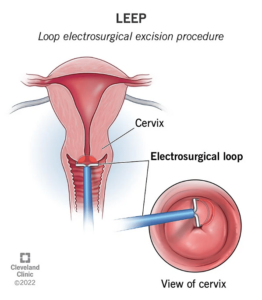At Diana Health, we care about your experience and want you to feel confident and prepared going into a LEEP procedure. Below is some information that will help you better understand what a LEEP is as well as the post-procedure instructions. Your healthcare provider will review all the necessary information with you when you meet on the day of your procedure. If you have any questions along the way, please ask. We care about you and want you to feel as comfortable as possible. We are only a call away and will be there with you throughout this process. Our doctors and Certified Nurse Midwives (CNMs) are experts at clinical procedures such as colposcopies, and you can rest assured that you are in good hands.
If your Diana Health team gives you any instructions that vary from what is below, please follow those instructions or modifications to this handout, as they know your medical history and the specifics of your upcoming procedure.
What is a LEEP?
LEEP stands for loop electrosurgical excision procedure. It may sound complex, but it will make more sense when we take it word by word. A LEEP is a PROCEDURE that uses a LOOP of wire that an ELECTRICAL current flows through. This electrical current allows the loop to EXCISE (or remove) precancerous cells from the cervix (opening of the womb to the vagina).
Possible reasons for a LEEP
LEEPs are done to remove abnormal cells from the cervix so that they don’t progress to cervical cancer (cancer of the cervix). Abnormal cells are often detected through a pap smear. This probably led to your healthcare provider recommending a colposcopy. A colposcopy involves looking at the cervix while a speculum is in the vagina, with a special device called a colposcope. The colposcope allows your healthcare provider to see the cervix very well with high-powered lighting and magnifying tools. For more information on colposcopies, see the informational sheet on Colposcopies with Diana Health.
During a colposcopy, a biopsy is often performed that removes a very small piece of the cervix and/or some cells from the cervical canal (where the cervix transitions into the “body” of the uterus/womb). These pieces of the cervix and/or cells from the cervical canal are sent to a pathologist who looks at the cells under a microscope to see how abnormal they look.
Sometimes the results from the pathologist tell your Diana Health provider that you need to be followed more closely with future colposcopies but that no further treatment is recommended at this time.
Other times, the results from the pathologist may indicate that the cells are precancerous and concerning enough that your Diana Health provider recommends a LEEP procedure to remove the abnormal cells.
By removing the cells when they are precancerous, the goal is that they never have a chance to develop into cervical cancer.
Different Types of LEEPs
The pathologist’s report as well as how your cervix looks to your Diana Health provider when they look at it through the colposcope, determines the type of LEEP you have.
Your healthcare provider wants to remove all of the precancerous cells so that they are not able to progress to cervical cancer. However, your provider does not want to remove more cervical tissue than is needed to do this.
Your Diana Health provider has special training to look at the cervix, interpret the pathologist report, and decide how to proceed. Based on these factors, they will choose the type of wire loop that is best to remove the precancerous cells.
Prior to the Procedure
Prior to your procedure, you will talk with your Certified Nurse Midwife or doctor to ensure that you understand the procedure. They will also answer any questions and ask you to sign a consent form.
Medications may be used….
If a medication is used that helps you relax prior to the procedure, you will want to bring a support person with to drive you home after the procedure as well as help you remember any follow-up instructions.
During the Procedure
Your Diana Health provider will walk you through the procedure, which usually only lasts a few minutes. They will explain what they are doing along the way. Your legs will be in stirrups and a speculum will be inserted so that your healthcare provider can see your cervix. They will likely use a colposcope so that they can see the cervix more clearly.
Numbing medicine and/or vinegar may be used during the procedure. You may feel some stinging and cramping when this is used.
A grounding pad is placed on your skin so that you are safe from the electrical current that is used during the procedure. The loop of wire is on the end of a wand allowing the healthcare provider to place the loop in the ideal position. The electrical current goes through the loop of wire causing the cervical tissue to be removed. During this time it is normal to notice a smell as this happens when the tissue is removed in this manner.
Depending on the extent of the abnormal cells, multiple passes may need to be done with the loop to remove tissue. Cells may also be collected from the lining of the cervical canal.
Also, after the procedure the electrical current may be used to stop any bleeding or a special paste may be placed onto the cervix to stop bleeding.
The healthcare provider will send this part of the cervix to the lab so that the pathologist can look at it and give you and your provider more information about the cells that were removed.
Recovery from a LEEP
- The recovery from a LEEP depends upon the extent of tissue removed and how any bleeding is stopped. After a LEEP, most women have watery pink and/or black/brown discharge for several days. The black/brown discharge is due to the paste that is often used to stop bleeding.
- Many women are able to return to work or school following the procedure; however, it is ideal if you can take the rest of the day off from any significant work.
- After a LEEP you should have pelvic rest (nothing in the vagina including vaginal intercourse, vibrators, or tampons) and no pools, hot tubs, or baths (showers are alright) for several weeks. This allows your cervix to heal.
- Your healthcare provider will let you know if there are any further restrictions.
- If you have cramping, you may take ibuprofen 600 mg every 8 hours as needed.
- If you have any problems after going home such as a temperature greater than 100.5, moderate to heavy bleeding, passing blood clots, severe pain or other concerns, you should seek care and reach out immediately.
- Make sure to keep your follow-up appointment with your Diana Health provider.
We know that hearing that you need a procedure such as a LEEP can cause anxiety, but at Diana Health we care about your entire experience and are only a phone call away. Please reach out with any questions or if you have any unexpected symptoms or if you need any assistance.
Helpful Visual of the LEEP Procedure




